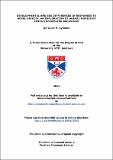Files in this item
Developmental and sex differences in responses to novel objects : an exploration of animal models of sensation seeking behaviour
Item metadata
| dc.contributor.advisor | Brown, Gillian R. | |
| dc.contributor.author | Cyrenne, De-Laine | |
| dc.coverage.spatial | 241 | en_US |
| dc.date.accessioned | 2012-04-10T10:42:47Z | |
| dc.date.available | 2012-04-10T10:42:47Z | |
| dc.date.issued | 2012-06-19 | |
| dc.identifier.uri | https://hdl.handle.net/10023/2550 | |
| dc.description | Electronic version excludes material for which permission has not been granted by the rights holder | en_US |
| dc.description.abstract | Human adolescents exhibit higher levels of sensation seeking behaviour than younger or older individuals, and sensation seeking is higher in males than females from adolescence onwards. Data suggest that changes in gonadal hormone levels during adolescence and differences in the dopamine neurotransmitter system are the bases for why some people exhibit sensation seeking behaviour while others do not. However, causal relationships between physiology and behaviour have been difficult to establish in humans. In order to explore the physiological influences on novelty-seeking behaviour, we looked at response to novelty in a laboratory rodent. This research examined responses to novelty in the conditioned place preference (CPP) task and the novel object recognition (NOR) task in Lister-hooded rats, and assessed the benefits and limitations of each methodology. While the CPP task was not found to provide a reliable measure of response to novelty, the NOR task was more successful. In order to understand the ontogeny of sex differences in novelty responses, both males and females were tested from adolescence through to adulthood. While no sex difference was found in adults in the NOR test, mid-adolescent males exhibited higher novelty preference behaviour than either younger or older males, or females at each stage of development. Since gonadal hormones levels rise during adolescence, a pharmacological agent (a gonadotrophin-releasing hormone antagonist) was used to suppress gonadal hormone levels from early adolescence before again examining responses on the NOR test at mid-adolescence. Gonadal hormone suppression from early adolescence onwards eliminated the sex difference in the NOR test at mid-adolescence by reducing the male response to novelty, while no difference was measured in the female animals. These findings suggest that gonadal hormones play a significant role in the development of response to novelty, especially in males, and the implications for our understanding of human sensation-seeking behaviour are discussed. | en_US |
| dc.language.iso | en | en_US |
| dc.publisher | University of St Andrews | |
| dc.rights | Creative Commons Attribution-NonCommercial-NoDerivs 3.0 Unported | |
| dc.rights.uri | http://creativecommons.org/licenses/by-nc-nd/3.0/ | |
| dc.subject | Sensation seeking | en_US |
| dc.subject | Hormones | en_US |
| dc.subject | Novelty | en_US |
| dc.subject | Sex difference | en_US |
| dc.subject | Novel object recognition | en_US |
| dc.subject | Age difference | en_US |
| dc.subject.lcc | QP356.45C8 | |
| dc.subject.lcsh | Sensation seeking | en_US |
| dc.subject.lcsh | Sensation seeking--Sex differences | en_US |
| dc.subject.lcsh | Animal behavior--Endocrine aspects | en_US |
| dc.subject.lcsh | Psychophysiology | en_US |
| dc.subject.lcsh | Rattus norvegicus | en_US |
| dc.title | Developmental and sex differences in responses to novel objects : an exploration of animal models of sensation seeking behaviour | en_US |
| dc.type | Thesis | en_US |
| dc.type.qualificationlevel | Doctoral | en_US |
| dc.type.qualificationname | PhD Doctor of Philosophy | en_US |
| dc.publisher.institution | The University of St Andrews | en_US |
| dc.identifier.doi | http://dx.doi.org/10.1002/dev.20542 | |
| dc.identifier.doi | http://dx.doi.org/10.1016/j.yhbeh.2011.08.015 |
This item appears in the following Collection(s)
Except where otherwise noted within the work, this item's licence for re-use is described as Creative Commons Attribution-NonCommercial-NoDerivs 3.0 Unported
Items in the St Andrews Research Repository are protected by copyright, with all rights reserved, unless otherwise indicated.


